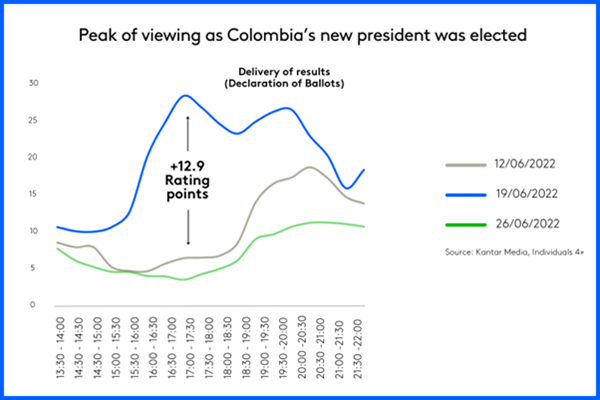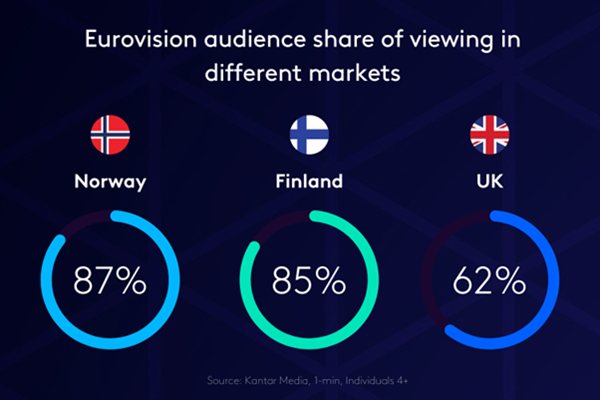In 2024, we are set to experience an array of landmark sporting, cultural and political events – but with new ways of accessing live content, how can we prepare for the pivotal moments to come?

If we look back to the world’s most viewed broadcasts, they are dominated by live events. Whether the climax of a sports fixture or moments of cultural or historical significance, these broadcasts have a unique power to bring nations – even the world – to a standstill. After all, they’re only live once and when there’s no script – anything can happen.
In 2024, we are set to experience an array of landmark sporting, cultural and political events – but with new ways of accessing live content, what can we learn from recent years to prepare for the pivotal moments to come? This article, inspired by a presentation at the 2023 World Audiences Summit, reflects on recent live events and explores how to unlock new insights by understanding their power in reaching mass audiences.
Sporting Moments
2024 is set to be the biggest year for sport since the pandemic with full crowds returning to the Summer Olympics in Paris and quadrennial continental football tournaments set to grip fans across the world with the European Championships in Germany and the Copa America, hosted this year in the United States.
Looking back, at the 2022 FIFA World Cup in Qatar, the world witnessed a thrilling climax as Leo Messi captained Argentina to victory. The final, perhaps unlike any similar event, has a unique ability to stop the world in its tracks. Indeed, the share figures recorded in Argentina (86%) and France (81%) were their highest recorded in recent years. Further, Argentina recorded 73% reach through its live TV broadcasts but this doesn’t account for the many millions more who watched in public places.
While final matches tend to gather large spikes in co-viewing, as families and friends come together to share in the spectacle – the tournaments are now watched across a range of screens and devices. Data from Kantar Media’s Global SportScope (40+ markets) reports that almost 30% of sports fans watched the FIFA World Cup 2022 on a smartphone and 17% on a computer. At this Summer’s Olympics – with more sports on show than ever before – we can expect those figures to increase as fans follow their favourite athletes and events and technology enables more fans to watch the moments that matter no matter where they are.
Political Moments
2024 has been dubbed the ‘year of democracy’ with estimates of more than 4 billion people being eligible to vote in elections held in over fifty countries and regions – including India, the US, the UK and the EU.
If I reflect on the recent example from my home country, Colombia, we can see the power of live moments in generating spikes in viewing. For example, in 2022 the moment that the new president was elected as the victor in our presidential election scored double the rating points of the typical timeslot. You can see the spike in ratings points in the graphic, below.

While sporting fixtures, generally, have fixed time slots allowing broadcasters, networks and advertisers to plan commercial airtime, election coverage is typically less predictable and shaped by the specificities of the electoral system in the market. For instance, the 2020 election in the US didn’t see Joe Biden officially projected as the winner by the news networks until five days after the polls had closed.
The key for broadcasters, networks and advertisers during periods of frenzied breaking news coverage – particularly around elections – is to be adaptable in your approach and ensure you can respond and change course quickly.
Cultural Moments
It may not be everybody’s idea of high culture, but the annual Eurovision Song Contest has an unparalleled ability as a non-sporting event to bring together a global audience. According to the European Broadcasting Union, last year’s contest in Liverpool reached 162 million viewers* – for context, this is 30% more than the most recent Superbowl in the US.
Kantar Media data shows that for some nations, Eurovision’s annual spectacle is a winner with audiences – dominating share for the broadcast of the 2023 Grand Final in Norway (87% share), Finland (85%), Lithuania (67%) and the host market of the UK (62%).

While Eurovision may stand out for its mass, international appeal, live music broadcasts more broadly such as the headline acts at festivals or the glitz of award ceremonies can capture the cultural zeitgeist and deliver strong audiences.
Understanding the full picture to harness the power of live events
The magic of live events lies in their ability to bring people together – no matter where they are or how they are watching. For rights holders, broadcasters or advertisers to harness their power, you need to build a complete picture that combines viewing across all screens and devices, with a people-centric approach to take into account the high levels of co-viewing.
Kantar Media unlocks those insights by designing and delivering cross-media measurement solutions that are tailored to each organisation’ specific needs and help them reach, engage and monetise their audience and investments across platforms. Our most recent solution, Cross-Platform ViewTM, already available in Spain and Brazil, provides subscribers with a full picture of the viewing landscape, including broadcaster and video-on-demand platforms in a single view.
To learn more about how Kantar Media can help to unlock the power of live events in your market, get in touch.